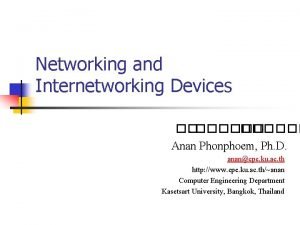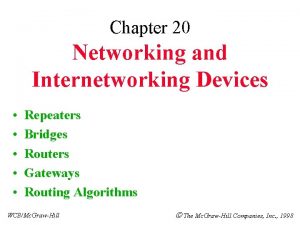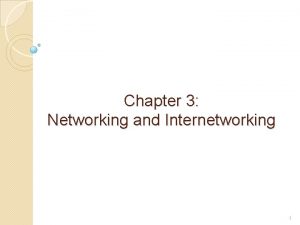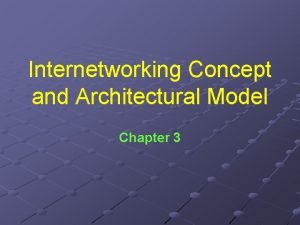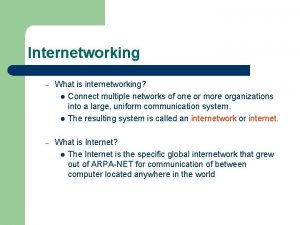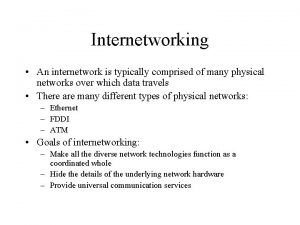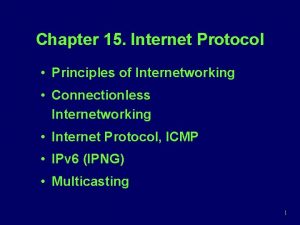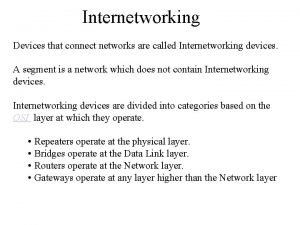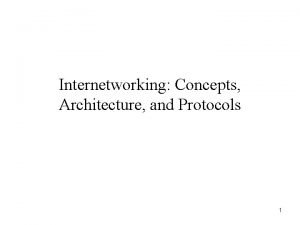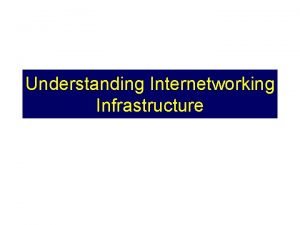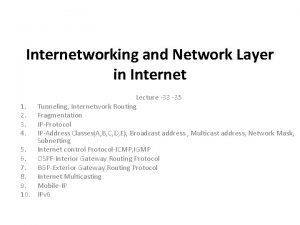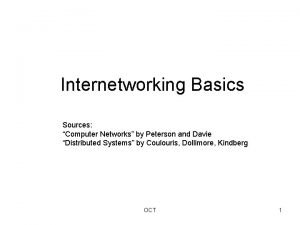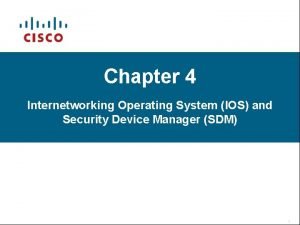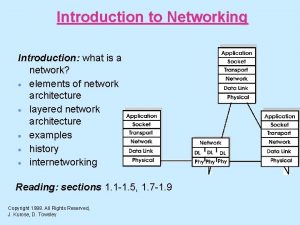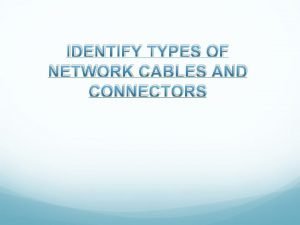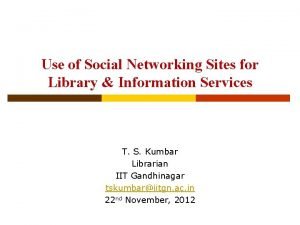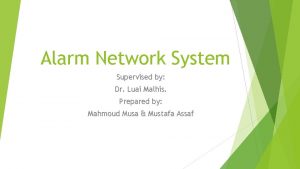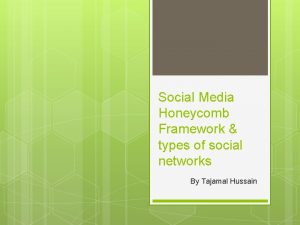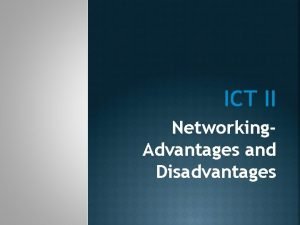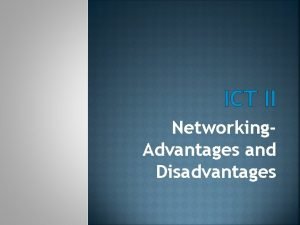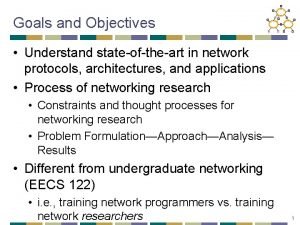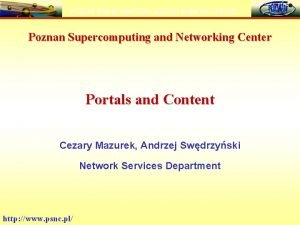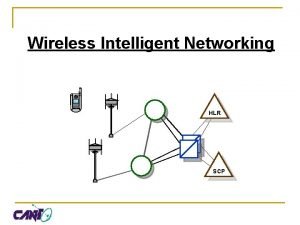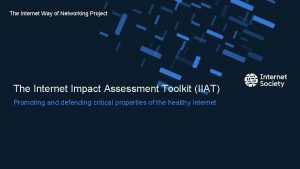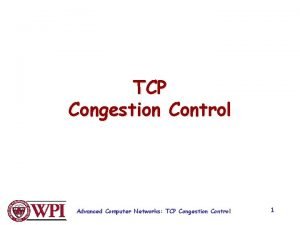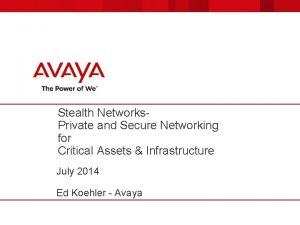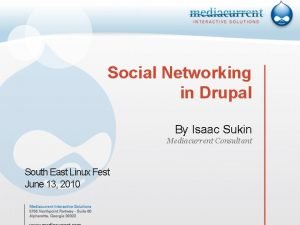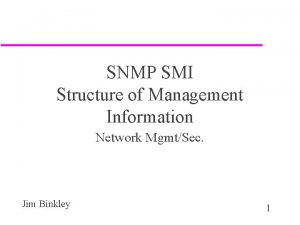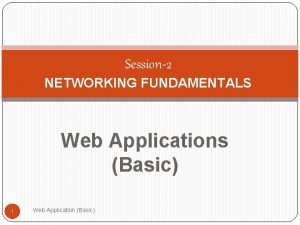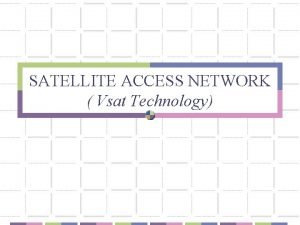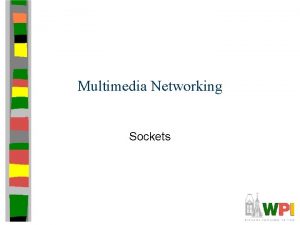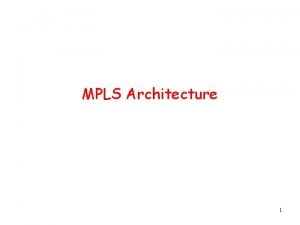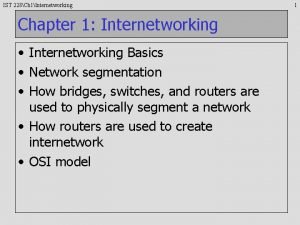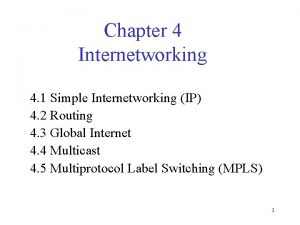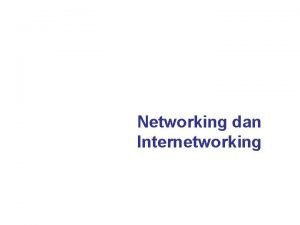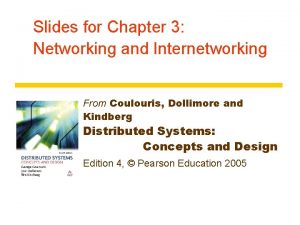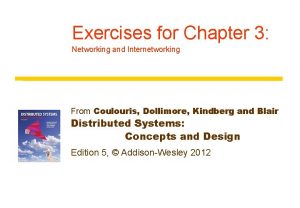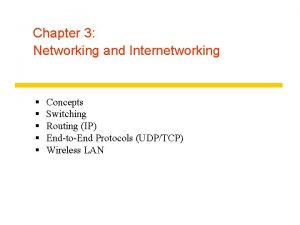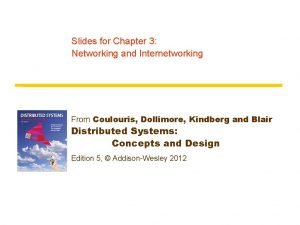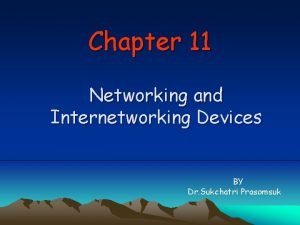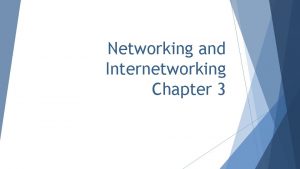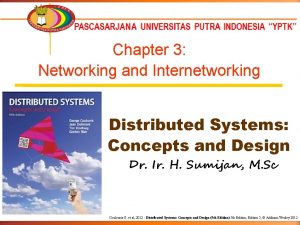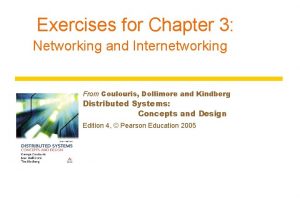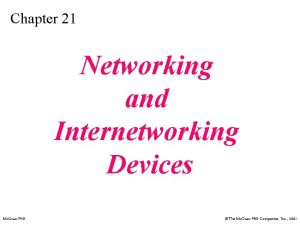Chapter 3 Networking and Internetworking Introduction Types of


















![Internet protocols • Protocol layers (n 1) – TCP(UDP)/IP, (n 2) web [HTTP], Email Internet protocols • Protocol layers (n 1) – TCP(UDP)/IP, (n 2) web [HTTP], Email](https://slidetodoc.com/presentation_image_h2/030e475e207e9259bff1f1d2c563331f/image-19.jpg)



















![Ethernet • IEEE 802. 3[Xerox 1973] – Carrier sensing, multiple access with collision detection Ethernet • IEEE 802. 3[Xerox 1973] – Carrier sensing, multiple access with collision detection](https://slidetodoc.com/presentation_image_h2/030e475e207e9259bff1f1d2c563331f/image-39.jpg)


















- Slides: 57

Chapter 3: Networking and Internetworking • • • Introduction Types of network Network principles Internet protocols Network case studies: Ethernet, wireless LAN and ATM • Summary

Concepts • Why should we study network technology? – Network is the basis of distributed system – The performance, reliability, scalability, … of the underlying networks impact the behavior of DS and therefore affect their design • Some concepts – transmission media : wire, cable, fiber and wireless channels – hardware devices : router, switch, bridge, hub, repeater and network interface – software components : protocol stacks, communication handler and driver – communication subsystem: the collection of hardware and software components that provide the communication facilities for a distributed system. – host : computers and devices that use the network for communication purpose – node : computer or switching device attached to a network – subnet : a unit of routing (delivering data from one part of Internet to another); it’s a collection of nodes that can be reached on the same physical network.

Networking issues for distributed systems • Performance – latency : the delay that occurs after a send operation is executed before data starts to arrive at the destination computer. It can be measured as the time to transfer an empty message. It forms a part of process-to-process latency. – data transfer rate : the speed at which data can be transferred between two computers in the network once transmission has begun, bits/s – Message transmission time = latency + length / data transfer rate – data transfer rate is determined primarily by network physical characteristics, whereas the latency is determined primarily by software overheads, routing delays and delay of accessing to transmission channels – In distributed systems, messages are always small in size, so the latency is more significant than data transfer rate – total system bandwidth : the total volume of traffic that can be transferred across the network in a given time. • Ethernet: system bandwidth is as same as data transfer rate • WAN: multiple channels, deteriorates when there are too many messages – Comparison of different communication channel • • local network – a null message transmission time is under a millisecond local memory - 1000 or more times faster than local network local hard disk - 500 times slower than fast local network Internet - round-trip latencies are in 300 -600 ms due to switching and contention

Networking issues for distributed systems … continued • Scalability – WWW: world wide web – future Internet: several billion nodes and hundreds of millions of active hosts, new addressing and routing mechanisms • Reliability – Networks are highly reliable, whereas client and server computers and their software often aren't, so error detection and recovery is best performed end-toend at the highest feasible level. – Errors: e. g. failures in software of sender or receiver, or buffer overflow • Security – Firewall: to protect the resources in all of the computers inside the organization from access by external users or processes and to control the use of resources outside the firewall by users inside the organization, always runs on a gateway – Secure network environment, e. g. VPN • Mobility – Although the current mechanisms have been adapted and extended to support them, the expected future growth in the use of mobile devices will require further extension • Qo. S – require guaranteed bandwidth and bounded latencies • Multicasting: Need for one-to-many communication

Chapter 3: Networking and Internetworking • • • Introduction Types of network Network principles Internet protocols Network case studies: Ethernet, wireless LAN and ATM • Summary

Types of network • Local area networks (LANs) – high speed, connected to a single communication medium, no routing of messages, may have switches or hubs – Ethernet, Token rings and … (1970 s), – 10 M -> 1000 M (G) • Wide area networks (WAN) – lower speeds, links between different cities, countries or continents – communication medium is a set of communication circuits linking a set of dedicated computers called routers • Metropolitan area networks (MANs) – Ethernet, ATM, DSL(digital subscriber line) • Wireless networks – IEEE 802. 11(Wave. LAN): 2 -11 mbps over 150 meters – WPANs (wireless personal area networks): infra-red links, Blue. Tooth (1 -2 mbps over 10 meters) – digital mobile phone network: European GSM/USA CDPD (up to 2 mbps) – WAP (Wireless Application Protocol)

Types of networks … continued • Internetworks – several networks are linked together to provide common data communication facilities that conceal the technology differences. – They are interconnected by routers and gateways – e. g. Internet • Network comparisons – different failure model : TCP vs. UDP

Chapter 3: Networking and Internetworking • • • Introduction Types of network Network principles Internet protocols Network case studies: Ethernet, wireless LAN and ATM • Summary

Network Switching technology • Packet switching – Store and forward, share communication link, asynchronous • Packet transmission – Messages: arbitrary length – Packet: restricted length • Sufficient buffer storage at each node, avoid undue delays • Data streaming – Video stream: bandwidth requirement, continues flow e. g. frame N arrives no more than N/24 seconds after the first frame arrives – Bandwidth, latency and reliability must be guaranteed: predefined route, e. g. ATM and IPv 6 • Switching schemes – – Broadcast: no switching, Ethernet Circuit switching: telephone system Packet switching Frame relay: combination of circuit switching and packet switching • Delay: Internet -200 milliseconds, telephone - 50 milliseconds, ATM - a few tens of microseconds

Network Protocols • Protocol – A specification of the sequence of messages that must be exchanged – A specification of the format of the data in the messages • Protocol layers – Each layer presents an interface to the layers above it that extends the properties of the underlying communication system – Layer encapsulations (n 1) • Protocol suits ( protocol stack) – Seven-layer Reference Model for OSI adopted by ISO – Simplify and generalize the communication interface, but bring significant cost, e. g. , N copies

Encapsulation of a packet

Other important concepts in network protocol • Packet assembly – Network–layer protocol packets: MTU (Maximum transfer unit), 1500 Bytes in Ethernet, 64 K in IP • Ports – Software definable destination points for communication within a host computer – Transport address = network address + port number, – Port numbers above 1023 are available for general use • Packet delivery – Datagram packet delivery, e. g. IP, Ethernet, and most wired and wireless LAN – Virtual circuit packet delivery, e. g. , ATM – Different to the concepts of Connection oriented (TCP)/Connectionless (UDP) in transport layer protocol

Routing • Routing algorithm – Determine the route taken by each packet. • Predetermined for circuit switching (e. g. X. 25) and frame relay switching (e. g. ATM); determine on the fly for packet switching – Dynamically update its knowledge of the network • Distance vector – Bellman-Ford protocol[1957] – RIP (router information protocol) • Periodically, and whenever the local routing table changes, send the router table to all accessible neighbours • When a table is received from a neighbouring router, make necessary update – Convergence problem – Improvement: link cost include bandwidth information, speed convergence, etc

Routing … continued • Link state algorithm – Each node maintains all knowledge of the network – Each node can compute appropriate routes based on the knowledge – Avoid slow convergence and undesirable intermediate states – E. g. OSPF

Congestion control • A rule of thumb – when the load on a network exceeds 80% of its capacity, the total throughput tends to drop as a result of packet losses • Congestion control – instead of allowing packets to travel through the network until they reach over-congested nodes, hold them at earlier nodes • Control approaches – Informing nodes along the congested route to reduce packet transmission rate, i. e buffering for long time at intermediate nodes or queue packets at source host – In the Internet, congestion control rely on the end-to-end traffic control, e. g. choke packets requesting a reduction in transmission rate in TCP

Internetworking • Internetwork – integrate many subnets that use different network technologies • Requirements – Unified internetwork addressing scheme that enables packets to be addressed to any host connected to any subnet – A protocol defining the format of internetwork packets and giving rules according to which they are handled – Interconnecting components that route packets to their destinations in terms of internetwork addresses, transmitting the packets using subnets with a variety of network technologies

Internetworking components • Router – Conduct routing, additionally link networks of different types • Bridge – link networks of different types, but not conduct routing • Hub – Connect hosts and extend segments of Ethernet and other broadcast local network • Switch – Perform similar function to router, but for LANs only • Tunnel – A software layer that transmits packets through an alien network environment

Chapter 3: Networking and Internetworking • • • Introduction Types of network Network principles Internet protocols Network case studies: Ethernet, wireless LAN and ATM • Summary
![Internet protocols Protocol layers n 1 TCPUDPIP n 2 web HTTP Email Internet protocols • Protocol layers (n 1) – TCP(UDP)/IP, (n 2) web [HTTP], Email](https://slidetodoc.com/presentation_image_h2/030e475e207e9259bff1f1d2c563331f/image-19.jpg)
Internet protocols • Protocol layers (n 1) – TCP(UDP)/IP, (n 2) web [HTTP], Email [SMTP, POP], news [NNTP], FTP, SSL, etc • Exceptions to the universal adoption of TCP/IP – The use of WAP for wireless applications on portable devices – Special protocols to support multimedia streaming applications • Heterogeneous underlying networks support – The success of TCP/IP: independence of the underlying transmission technology (n 3) – E. g. , IP over ATM, IP over Ethernet, IP over PPP, etc

Internet protocol layers Layers Message Application Messages (UDP) or Streams (TCP) Transport UDP or TCP packets Internet IP datagrams Network interface Network-specific frames Underlying network

Encapsulation in a message transmitted via TCP over an Ethernet Application message TCP header IP header TCP Ethernet header IP Ethernet frame port

The programmer’s conceptual view of a TCP/IP Internet

IP addressing • Schemes for naming and addressing hosts and for routing IP packets to their destination is challenging. • Requirement: – It must be universal – It must be efficient – The addressing scheme must lend itself to the development of routing scheme • The scheme – A 32 -bit numeric identifier containing a network identifier and a host identifier – There are four allocated classed of Internet address-A, B, C, D

Internet address structure 28

Decimal representation of Internet addresses octet 1 octet 2 Network ID Class A: 1 to 127 octet 3 Host ID 0 to 255 Network ID Class B: 128 to 191 192 to 223 0 to 255 1. 0. 0. 0 to 127. 255 Host ID 0 to 255 Network ID Class C: Range of addresses 0 to 255 128. 0. 0. 0 to 191. 255 Host ID 0 to 255 1 to 254 192. 0. 0. 0 to 223. 255 Multicast address Class D (multicast): 224 to 239 0 to 255 1 to 254 Class E (reserved): 240 to 255 1 to 254 224. 0. 0. 0 to 239. 255 240. 0 to 255 Two steps were taken: IPv 6, Classless interdomain routing (CIDR)

IP protocol • Transmits datagrams from one host to another, if necessary via intermediate routers – Unreliable (best-effort) delivery semantics • packets can be lost, duplicated, delayed or delivered out of order – Address resolution: Address Resolution Module(ARP) • IP address -> Ethernet address mapping, (IP address, Ethernet address) pairs cache on each host

IP routing • Routs packets from source to destination – Internet topology: Autonomous System, Areas(n 1) – Routing algorithms: • RIP -1 • RIP-2 • Open Short Path First (OSPF) – Default routes: trade routing efficiency for table size – Classless interdomain routing (CIDR): create subnet by means of subdividing address or aggregating addresses by mask field, e. g. 162. 105. 203. 0/24

Internet topology

Future of IP • IPv 6(n 1) – 2128 (3*1038) addresses, 1000 IP addresses per square meter of the Earth’s surface – Routing speed : no checksum, no fragmentation – Real time : priority and flow label which is used to reserve resources – Extension header ( information of router, authentication, etc), – multicast and anycast – Security through extension header type • Migration from IPv 4: – IPv 6 router island, – depend on economics

IPv 6 header layout

The Mobile. IP routing mechanism Sender Address of FA returned to sender Subsequent IP packets tunnelled to FA Mobile host MH First IP packet addressed to MH Internet Home agent Foreign agent FA First IP packet tunnelled to FA

TCP and UDP • Use of ports – Provide process-to-process communication • UDP features • TCP features

UDP features • Connectionless • Datagram delivery – A UDP datagram is encapsulated inside an IP packet, up to 64 kb in size • Con – unreliable delivery due to unreliable IP • Pro – minimal additional cost and transmission delays

TCP • Connection oriented – two side must shake hands to establish a bi-directional communication channel • Message delivery – Deliver arbitrary long sequences of bytes via stream-based programming abstraction – Sequencing: divide stream into data segments, sequence number on each segment – Checksum: cover the header and the data in the segment • Flow control – Receiver send the highest number of received segment and window size to sender by acknowledge message – Buffering: receiver buffer and sender buffer used for flow control – In interactive application, receiver inform sender when timeout or the buffer reaches the MTU limit – Retransmission: retransmit the segment when no acknowledgement within a specified timeout

Domain names • Symbolic names for hosts and networks – pku. edu. cn • The DNS would not workable without the extensive use of caching.

Firewall • The purpose of a firewall is to monitor and control all communication into and out of an intranet – including service control, – behavior control – and user control • Filter approaches (n 1) – IP packet filtering, e. g. router/filter – TCP gateway, e. g. bastion – Application level gateway, e. g. telnet proxy process • Virtual private networks (VPN) – Secure connections located at different sites using public Internet links – By the use of cryptographically protected secure channels at the IP level

Firewall configurations

Chapter 3: Networking and Internetworking • • • Introduction Types of network Network principles Internet protocols Network case studies: Ethernet, wireless LAN and ATM • Summary
![Ethernet IEEE 802 3Xerox 1973 Carrier sensing multiple access with collision detection Ethernet • IEEE 802. 3[Xerox 1973] – Carrier sensing, multiple access with collision detection](https://slidetodoc.com/presentation_image_h2/030e475e207e9259bff1f1d2c563331f/image-39.jpg)
Ethernet • IEEE 802. 3[Xerox 1973] – Carrier sensing, multiple access with collision detection – Frame broadcasting – Bandwidth: 3 m -> 100 m -> 1000 m • Ethernet packet layout (n 1) – 248 different addresses • Packet collisions – Carrier sensing • wait until no signal is present then transmit – Collision detection • When transmit through output port, also listen on the input port, and compare the two signals, If differ, send jamming signal

Ethernet frame layout 7 bytes 1 byte preamble S 6 bytes Destination address 2 bytes Source Length address of data 46 bytes ≤ length ≤ 1500 bytes Data for transmission 4 bytes Frame check sequence

Ethernet … continued • Ethernet efficiency – Efficiency = number of packets transmitted successfully / theoretical maximum number without collision – Affected by • A finite time for a signal inserted at a point in the media to reach all other points • number of stations on the network • stations’ level of activity

Wireless LAN • Wireless LAN types – Infrastructure network, e. g. IEEE 802. 11 (n 1) – Ad hoc network: network built on the fly • Collision detection failures in 802. 11 – Hidden stations: carrier sensing fail to detect that another station on the network is transmitting, lead to collision at base station – Fading: the strength of radio signals diminishes rapidly with the distance from the transmitter, so that defeating both carrier sensing and collision detection – Collision masking

Wireless LAN configuration

802. 11 introduction • Slot reservation added to the MAC protocol in 802. 11 1. Firstly, sense the medium, if no carrier signal, then • • • medium is available an out-of-range station is in the process of requesting a slot an out-of-range station is using a slot 2. Sender send a RTS (Request To Send) frame to receiver; Receiver reply a CTS (Clear To Send) frame to sender. The effect of the exchange is • • the station within range of sender will pick up the RTS frame and take note of the duration the station within range of receiver will pick up the CTS frame and take note of the duration 3. Begin to transmit

802. 11 introduction … continued • 802. 11 avoid collisions in ways – CTS frames avoid the hidden station and fading problem – If RTS/CTS is corrupted, then a back-off period is used – When RTS/CTS exchange correctly, there is no collisions in the following communication except intermittent fading prevents a third party from receiving either of them • Security in 802. 11 – Shared-key authentication mechanism – XOR operation on the base of shared key to prevent from eavesdropping

Asynchronous Transfer Mode networks (ATM) • Deploy ATM on top of other networks – Can be implemented over existing digital telephony networks, Bandwidth from 32 kbps (voice). – Native mode: Over optical fiber, copper and other transmission media, bandwidth up to several gigabits per seconds • ATM layers (n 1) – Adaptation layer • end-to-end layer implemented at the sending and receiving host – ATM layer • connection-oriented service that transmits fixed length packets called cells, avoid flow control and error checking at the switching, provide bandwidth and latency guarantees • VC (virtual channel): a logical unidirectional association between two endpoints of a link in the physical path from source to destination • VP (virtual path): a bundle of virtual channel that are associated with a physical path between two switching nodes

ATM protocol layers

ATM… continued • The nodes in a ATM network can play three distinct roles (n 1) – Hosts: send and receive messages – VP switches: hold tables showing the correspondence information between incoming and outgoing VPs – VP/VC switches: correspondence information for both VPs and VCs • ATM cell: 5 -bytes header and a 48 -byte data field

Switching virtual paths in an ATM network

Chapter 3: Networking and Internetworking • • • Introduction Types of network Network principles Internet protocols Network case studies: Ethernet, wireless LAN and ATM • Summary

Summary • Layered protocols – 7 layers in OSI model / 5 layers in the Internet • Delivery approach – Packet switch, frame relay • Routing mechanism – distance vector / link state • Congestion control • The Internet – TCP/IP • Network cases – Ethernet, WLAN, ATM

OSI protocol summary Layer Description Examples Application Protocols that are designed to meet the communication requirements of specific applications, often defining the interface to a service. HTTP, FTP , SMTP, CORBA IIOP Presentation Protocols at this level transmit data in a network representation that is independent of the representations used in individual computers, which may differ. Encryption is also performed in this layer, if required. Secure Sockets (SSL), CORBA Data Rep. Session At this level reliability and adaptation are performed, such as detection of failures and automatic recovery. EJB Transport This is the lowest level at which messages (rather than packets) are handled. Messages are addressed to communication ports attached to processes, Protocols in this layer may be connection-oriented or connectionless. TCP, UDP Network Transfers data packets between computers in a specific network. In a WAN or an internetwork this involves the generation of a route passing through routers. In a single LAN no routing is required. IP, ATM virtual circuits Data link Responsible for transmission of packets between nodes that are directly Ethernet MAC, connected by a physical link. In a WAN transmission is between pairs of ATM cell transfer, routers or between routers and hosts. In a LAN it is between any pair of hosts. PPP Physical The circuits and hardware that drive the network. It transmits sequences of Ethernet base- band binary data by analogue signalling, using amplitude or frequency modulation signalling, ISDN of electrical signals (on cable circuits), light signals (on fibre optic circuits) or other electromagnetic signals (on radio and microwave circuits).

Distance-Vector Routing table for the network Routings from A To Link Cost A local 0 B 1 1 C 1 2 D 3 1 E 1 2 A Hosts or local networks Routings from B To Link Cost A 1 1 B local 0 C 2 1 D 1 2 E 4 1 1 3 Routings from D To Link Cost A 3 1 B 3 2 C 6 2 D local 0 E 6 1 B 2 Links 4 C 5 D 6 Routings from C To Link Cost A 2 2 B 2 1 C local 0 D 5 2 E 5 1 E Routers Routings from E To Link Cost A 4 2 B 4 1 C 5 1 D 6 1 E local 0

Psudo-code for RIP routing algorithm Send: Each t seconds or when Tl changes, send Tl on each non-faulty outgoing link. Receive: Whenever a routing table Tr is received on link n: for all rows Rr in Tr { if (Rr. link <> n) { Rr. cost = Rr. cost + 1; Rr. link = n; if (Rr. destination is not in Tl) add Rr to Tl; // add new destination to Tl else for all rows Rl in Tl { if (Rr. destination = Rl. destination and (Rr. cost < Rl. cost or Rl. link = n)) Rl = Rr; // Rr. cost < Rl. cost : remote node has better route // Rl. link = n : remote node is more authoritative } } }

Simplified view of the QMW Computer Science network Campus router 138. 37. 95. 240/29 subnet 138. 37. 95. 241 router/ firewall hammer Staff subnet 138. 37. 88. 251 138. 37. 88 compute server 138. 37. 94. 251 Eswitch 138. 37. 94 file server/ gateway Eswitch bruno 138. 37. 88. 249 % Student subnet custard 138. 37. 94. 246 dialup server henry 138. 37. 88. 230 printers other servers file server hotpoint 138. 37. 88. 162 web server copper 138. 37. 88. 248 hub desktop computers Campus router 138. 37. 95. 248/29 subnet hub 138. 37. 88. xx desktop computers sickle 138. 37. 95. 249 router/ firewall 138. 37. 94. xx 100 Mbps Ethernet 1000 Mbps Ethernet Eswitch: Ethernet switch

Tunnelling IPv 6 encapsulated in IPv 4 packets A IPv 6 IPv 4 network IPv 6 B Encapsulators IP encapsulated in PPP packets A IP PPP network Encapsulators IP B

ATM cell layout
 Decision tree
Decision tree Networking and internetworking devices
Networking and internetworking devices Internetworking basics
Internetworking basics Sdn vs traditional networking
Sdn vs traditional networking Internetworking concept and architectural model
Internetworking concept and architectural model Introduction to data communications and networking
Introduction to data communications and networking What is internetworking
What is internetworking Advantages of internetworking
Advantages of internetworking Hah
Hah Connectionless internetworking
Connectionless internetworking Internet working devices
Internet working devices Internetworking concepts
Internetworking concepts Internetworking business model
Internetworking business model Internetworking in network layer
Internetworking in network layer Cell switching in computer networks
Cell switching in computer networks Fileserver138
Fileserver138 Internetworking operating system
Internetworking operating system Introduction of networking
Introduction of networking Types of network cables and connectors
Types of network cables and connectors Types of social networking sites
Types of social networking sites Alarm types in networking
Alarm types in networking Backbone network components
Backbone network components Business data communication and networking
Business data communication and networking Disadvantages of social network
Disadvantages of social network Persuation and networking
Persuation and networking Essay advantages and disadvantages
Essay advantages and disadvantages Ictii
Ictii Computer network assignment
Computer network assignment Jalinan dan jaringan (networking and linkages)
Jalinan dan jaringan (networking and linkages) Pengertian kolaborasi jaringan
Pengertian kolaborasi jaringan Goals of network layer
Goals of network layer Analog and digital signals in computer networking
Analog and digital signals in computer networking Transmission basics and networking media
Transmission basics and networking media Poznan supercomputing and networking center
Poznan supercomputing and networking center Error detection and correction in computer networks
Error detection and correction in computer networks Optical switching and networking
Optical switching and networking Business data communications and networking
Business data communications and networking Any time interrogation call flow
Any time interrogation call flow Cisco networking academy uk
Cisco networking academy uk Networking spheres
Networking spheres Internet way of networking
Internet way of networking Jacobson/karels algorithm
Jacobson/karels algorithm Stealth networks
Stealth networks Soho networking meaning
Soho networking meaning Drupal social networking
Drupal social networking What is smi in networking
What is smi in networking Web
Web What is vmsat
What is vmsat Raw sockets in unix network programming
Raw sockets in unix network programming International networking adalah
International networking adalah Optical networking technology
Optical networking technology Network communication models
Network communication models Networking skills
Networking skills Networking fundamentals
Networking fundamentals What is jitter and latency
What is jitter and latency Socket in networking
Socket in networking Grotto networking
Grotto networking Mpls ler
Mpls ler
